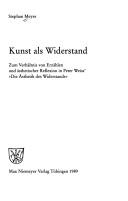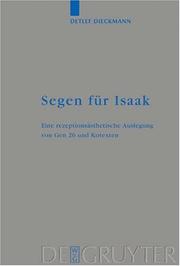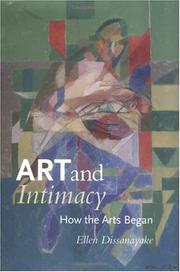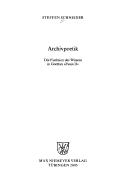| Listing 1 - 10 of 14 | << page >> |
Sort by
|
Book
ISBN: 9782842787783 Year: 2010 Publisher: Paris Beauxarts
Abstract | Keywords | Export | Availability | Bookmark
Book
ISBN: 3416022289 9783416022286 Year: 1990 Volume: 45 Publisher: Bonn Bouvier
Abstract | Keywords | Export | Availability | Bookmark
 Loading...
Loading...Choose an application
- Reference Manager
- EndNote
- RefWorks (Direct export to RefWorks)

ISBN: 3484181028 9783484181021 Year: 1989 Volume: 102 Publisher: Tübingen Niemeyer
Abstract | Keywords | Export | Availability | Bookmark
 Loading...
Loading...Choose an application
- Reference Manager
- EndNote
- RefWorks (Direct export to RefWorks)

ISBN: 3110177617 3110892391 9783110177619 Year: 2015 Volume: 329 Publisher: Berlin ; Boston : De Gruyter,
Abstract | Keywords | Export | Availability | Bookmark
 Loading...
Loading...Choose an application
- Reference Manager
- EndNote
- RefWorks (Direct export to RefWorks)
In Abgrenzung zur romantischen Ästhetik der Originalität geht die Analyse des Textes von Gen 26 und seinen Kotexten von einer Ästhetik der Wertschätzung von Wiederholungen und "Doppelungen" aus. Nach der Vorstellung des rezeptionsästhetischen Auslegungskonzeptes wird der Lektüreprozess von Gen 12,10-20; Gen 20 und Gen 26 rekonstruiert, wobei nicht nur die christliche Sekundärliteratur, sondern auch jüdische Exegesen intensiv einbezogen werden. Die drei Geschichten von der Gefährdung der Ahnfrau und die beiden Brunnenstreit-Erzählungen werden als jeweils neue Folgen sichtbar, die mit Gen 26 in einer erzähltechnisch anspruchsvollen Friedens- und Segensgeschichte ihren Höhepunkt finden. In contrast to the romantic aesthetic of originality, this analysis of the texts of Genesis 26 and its co-texts proceeds from an aesthetic of valuing repetitions and 'doubling'. After presenting the concept of interpretation based on a reception aesthetic, the study reconstructs the process of reading Genesis 12:10–20, Genesis 20 and Genesis 26, considering not only Christian secondary literature, but also making extensive use of Jewish exegeses.
222.2 --- Genesis --- Bible. --- Criticism, interpretation, etc. --- Erzähltechnik. --- Genesis. --- Pentateuc. --- Rezeption. --- Rezeptionsästhetik --- Exegese --- RELIGION / Biblical Criticism & Interpretation / Old Testament. --- Bibelauslegung --- Bibelexegese --- Biblische Auslegung --- Bibelinterpretation --- Biblische Exegese --- Schriftauslegung --- Bibelwissenschaft --- Exeget --- Bibel --- Rezeptionstheorie --- Wirkungsästhetik --- Kunstwerk --- Literaturtheorie --- Ästhetik --- Rezeption --- Wirkungsästhetik --- Ästhetik
Book
ISBN: 9781606065563 1606065564 Year: 2018 Publisher: Los Angeles, Calif. The Getty Research Institute
Abstract | Keywords | Export | Availability | Bookmark
 Loading...
Loading...Choose an application
- Reference Manager
- EndNote
- RefWorks (Direct export to RefWorks)
Giovanni Andrea Gilio's Dialogue on the Errors and Abuses of Painters (1564) is one of the first treatises on art published in the post-Tridentine period. It remains a key primary source for the discussion of the reform of art as it unfolded at the time of the Council of Trent and the Catholic Reformation. Through a spirited conversation among six protagonists, Gilio grapples with a host of issues, from the relationship between poetry and painting, to the function of religious images, to the effects such images have on viewers. The primary focus is the proper representation of history, especially sacred history, and Michelangelo's Last Judgment fresco in the Sistine Chapel is the exemplary case. Michelangelo's painting is both praised and condemned as an example of the possibilities and limits of art. Although Gilio's dialogue is often used to point out the Roman Catholic Church's more controlling view of art and artists, the unabridged text--here translated into English in full for the first time--reveals the nuanced and provisional debates about how subject matter should be represented in this crucial period--Cover page 4.
art theory --- Aesthetics of art --- anno 1500-1599 --- Italy --- Painting --- Painting, Italian --- Painting, Renaissance --- Kritik --- Ästhetik --- Malerei --- Gilio, Giovanni Andrea --- Geschichte 1564 --- Italien --- Painting, Italian. --- Kritik. --- Ästhetik. --- Malerei. --- Italien. --- Ästhetik. --- Italian painting --- Gilio, Giovanni Andrea,

ISBN: 0295979119 9780295997469 029599746X 9780295979113 Year: 2012 Publisher: Seattle, Wash. : Univ. of Washington Press,
Abstract | Keywords | Export | Availability | Bookmark
 Loading...
Loading...Choose an application
- Reference Manager
- EndNote
- RefWorks (Direct export to RefWorks)
Arts and society. --- Intimacy (Psychology). --- Arts and society --- Arts et société --- Intimacy (Psychology) --- Intimiteit (Psychologie) --- Intimité (Psychologie) --- Kunsten en maatschappij --- Arts et société --- Intimité --- Arts --- Arts and sociology --- Society and the arts --- Sociology and the arts --- Emotions --- Interpersonal relations --- Love --- Social aspects --- Ästhetik --- Künste --- Kunst --- Intimsphäre --- Gesellschaft --- Entwicklung --- Ursprung --- Entwicklungsstadium --- Fortschritt --- Entstehung --- Evolution --- Sein --- Geheimbereich --- Intimität --- Privatsphäre --- Bildende Kunst --- Kunstdenkmal --- Kunstwerk --- Schöne Künste --- Kunstästhetik --- Kunstphilosophie --- Kunsttheorie --- Philosophische Ästhetik --- Kunstanschauung --- Kunstauffassung --- Philosophie --- Ästhetizismus --- Ästhetisches Handeln --- Ästhetisches Verhalten --- Ästhetisches Ideal --- Ästhetisches Objekt --- Ästhetisches Urteil --- Theorie --- Schöne Künste --- Künste
Book
ISBN: 2256910970 9782256910975 Year: 2005 Volume: 5 Publisher: Paris Lettres modernes
Abstract | Keywords | Export | Availability | Bookmark
 Loading...
Loading...Choose an application
- Reference Manager
- EndNote
- RefWorks (Direct export to RefWorks)
Flaubert, Gustave --- Flaubert, Gustave, --- Hegel, Georg Wilhelm Friedrich, --- Criticism and interpretation. --- Criticism and interpretation --- 840 "18" FLAUBERT, GUSTAVE --- Franse literatuur--19e eeuw. Periode 1800-1899--FLAUBERT, GUSTAVE --- 840 "18" FLAUBERT, GUSTAVE Franse literatuur--19e eeuw. Periode 1800-1899--FLAUBERT, GUSTAVE --- Flaubert, Gustave, - 1821-1880 - Criticism and interpretation --- Hegel, Georg Wilhelm Friedrich, - 1770-1831 - Ästhetik --- Flaubert, Gustave, - 1821-1880

ISSN: 04407164 ISBN: 3484151080 3110940981 Year: 2011 Volume: n.F., Bd. 108 Publisher: Tübingen : Max Niemeyer Verlag,
Abstract | Keywords | Export | Availability | Bookmark
 Loading...
Loading...Choose an application
- Reference Manager
- EndNote
- RefWorks (Direct export to RefWorks)
Zu den Eigentümlichkeiten des »Faust II« gehört es, dass Goethe darin eine Vielzahl von Wissenselementen eingearbeitet hat. Die Funktion dieser Anspielungsfülle wird mit dem Begriff der 'Archivpoetik' belegt. Damit werden drei Aspekte der Bezugnahme auf das Archiv der Epoche bezeichnet, deren Untersuchung sich diese Studie widmet. Erstens stellt sie Goethes gelehrtes Verfahren in einen Bezug zur Wissens- und Wissenschaftsgeschichte. Dies geschieht beispielhaft, indem sie die Bedeutung der Geologie, der wissenschaftlichen Mythosforschung, der Philologie und der Weltliteratur für das Drama herausstellt. Zweitens fragt sie nach den Verfahren, die dieses Wissen poetisieren: Durch Selektion und Rekombination erfährt das Archiv eine Dramatisierung, durch die es überschritten wird. Doch zugleich bleibt der dramatische Text auf die in ihm geborgenen Wissensinhalte transparent. So bildet das Archiv ein Reflexionsmedium, in dem sich die Dichtung in ihrem Verhältnis zum Wissen selbst thematisieren kann. Diese Reflexion betrifft insbesondere die Möglichkeit symbolischer Repräsentation in der Zeit einer radikalen Temporalisierung des Wissens, die im »Faust II« zur ästhetischen Utopie wird, während ihre Realisierung aber durch die moderne Wissenschaft in Frage gestellt ist. Die Modernität des »Faust II« muss daher weniger in seinen Gegenständen als vielmehr in dieser Form der Selbstreflexion der Poesie gesehen werden.
Goethe, Johann Wolfgang von --- Goethe, Johann Wolfgang von, --- Goethe, Johann Wolfgang von / Faust II. --- Intertextualität. --- Poetik. --- Wissen ‹Motiv›. --- Wissen. --- Wissen --- Intertextualität --- Poetik --- LITERARY CRITICISM / European / German. --- Ästhetik --- Dichtungstheorie --- Literarästhetik --- Literaturästhetik --- Dichtkunst --- Literaturtheorie --- Poetologie --- Kenntnis --- Kenntnisse --- Erkenntnis --- Wissensproduktion --- Textualität --- Transtextualität --- Intermedialität --- Interpikturalität --- Motiv --- Literatur --- Ästhetik --- Literarästhetik --- Literaturästhetik
Book
ISBN: 9781472477125 9781315197739 147247712X 9781351770873 Year: 2017 Publisher: London Routledge
Abstract | Keywords | Export | Availability | Bookmark
 Loading...
Loading...Choose an application
- Reference Manager
- EndNote
- RefWorks (Direct export to RefWorks)
Rubens and the Eloquence of Drawing' re-examines the early graphic practice of the preeminent northern Baroque painter Peter Paul Rubens (Flemish, 1577-1640) in light of early modern traditions of eloquence, particularly as promoted in the late sixteenth- and early seventeenth-century Flemish, Neostoic circles of philologist, Justus Lipsius (1547-1606). Focusing on the roles that rhetorical and pedagogical considerations played in the artist's approach to disegno during and following his formative Roman period (1600-08), this volume highlights Rubens's high ambitions for the intimate medium of drawing as a primary site for generating meaningful and original ideas for his larger artistic enterprise. As in the Lipsian realm of writing personal letters - the humanist activity then described as a cognate activity to the practice of drawing - a Senecan approach to eclecticism, a commitment to emulation, and an Aristotelian concern for joining form to content all played important roles. Two chapter-long studies of individual drawings serve to demonstrate the relevance of these interdisciplinary rhetorical concerns to Rubens's early practice of drawing.
Drawing --- Rubens, Peter Paul --- Rubens, Peter Paul, --- Rubens, --- Rubens, P. P. --- Rubens, Pierre-Paul, --- Rubens, Pieter Paul, --- Rubens, Pieter-Pauwel, --- Rubens, Pietro Paolo, --- רובנס, פטר פאול, --- Criticism and interpretation. --- Rubens, Pieter Paul --- Rubens --- Rubens, Pierre-Paul --- Rubens, Pieter-Pauwel --- Rubens, Pietro Paolo --- Drawing, Flemish. --- Ästhetik --- Zeichnung --- Lipsius, Justus --- 1500-1699
Book
ISBN: 9783484630390 3484630396 3119167118 9786612197253 1282197258 3484970421 9783484970427 Year: 2008 Volume: 39 Publisher: Tübingen Max Niemeyer
Abstract | Keywords | Export | Availability | Bookmark
 Loading...
Loading...Choose an application
- Reference Manager
- EndNote
- RefWorks (Direct export to RefWorks)
Zwei epochale Werke, die beide im Jahre 1932 erschienen, werden in dieser Studie mit Blick auf die Frage nach der Beziehung der Kunst zur gesellschaftlichen Praxis umfassend interpretiert: der Roman »Voyage au bout de la nuit« von Louis-Ferdinand Céline und die Romantrilogie »Die Schlafwandler« von Hermann Broch. Den gemeinsamen Stoff beider Werke bildet die historische Situation Europas nach dem Ersten Weltkrieg, die als Krise dargestellt wird. Das Sendungsbewusstsein beider Autoren legt es nahe, ihre Romane auf die Gestaltung des Verhältnisses ästhetischer, ethischer und kognitiver Komponenten in einem literarischen Werk hin zu untersuchen. Die Spannung zwischen dem Postulat der Kunstautonomie, wie es sich seit der Aufklärung entwickelte, und dem Anspruch auf eine gesellschaftliche Relevanz, den beide Autoren von ihrer kulturkritischen Haltung her entwickeln, führt zu der Frage, inwieweit und auf welche Art das literarische Werk eine 'therapeutische' Sendung in Zeiten der Krise übernehmen kann. Umfassende Textanalysen und Interpretationen zeigen, wie beide Werke unabhängig von den Absichten ihrer Autoren eine eigene Dynamik entwickeln, die auf Strategien der Erschütterung baut.
Broch, Hermann. --- Broch, Hermann, 1886-1951. Schlafwandler. --- Celine, Louis-Ferdinand. --- Céline, Louis-Ferdinand, 1894-1961. --- Ce ́line, Louis-Ferdinand, 1894-1961. Mort a` cre ́dit. --- Ce ́line, Louis-Ferdinand, 1894-1961. Voyage au bout de la nuit. --- Céline, Louis-Ferdinand. --- French Literature --- Romance Literatures --- Languages & Literatures --- Céline, Louis-Ferdinand, --- Broch, Hermann, --- Ethik. --- Literary Theory, Novel, Ethics, Esthetics. --- Literaturtheorie. --- Roman. --- Ästhetik. --- Ethik --- Ästhetik --- LITERARY CRITICISM / European / French. --- Künste --- Kunstästhetik --- Kunstphilosophie --- Kunsttheorie --- Philosophische Ästhetik --- Kunstanschauung --- Kunstauffassung --- Philosophie --- Ästhetizismus --- Ästhetisches Handeln --- Ästhetisches Verhalten --- Ästhetisches Ideal --- Ästhetisches Objekt --- Ästhetisches Urteil --- Ethische Theorie --- Moral --- Philosophische Ethik --- Sittenlehre --- Moralphilosophie --- Ethiker --- Praktische Philosophie --- Ästhetik --- Theorie --- Celine, Louis-Ferdinand,
| Listing 1 - 10 of 14 | << page >> |
Sort by
|

 Search
Search Feedback
Feedback About UniCat
About UniCat  Help
Help News
News